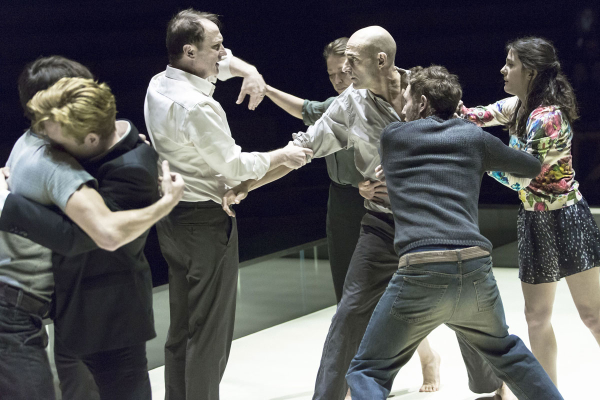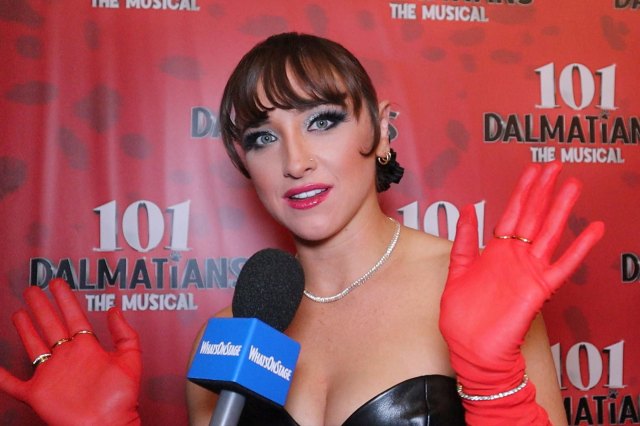Matt Trueman: Is it time for theatre to return to a spirit of excess?
There’s a trend for pared back, greyscale theatre, but Matt Trueman asks if it’s the best way forward

© Jan Versweyveld
British theatre is going through a minimalist phase. It is stripping itself back, paring itself down to its bare essentials. The new governing principles are these: Less is more. Excess is out. Greyscale is good.
It is, perhaps, a mark of Ivo Van Hove‘s influence and, in particular, A View from the Bridge for the Young Vic. That production practically gutted Arthur Miller‘s play, chucking out anything not strictly necessary. Out went the Carbone’s Red Hook home, out went their furniture, out went every prop bar a single chair, all colour except a single floral top and a shower of blood, and yet – boom – here was the play in its absolute entirely, its emotions maxed out, its innards on show.
The Belgian director talks of tapping into a play’s essence, attempting "to liberate a play’s hidden forces." A recent New Yorker profile gives a glimpse into his process: the moment he decides they don’t need a knife for the fight at the end, the moment he orders his actors to take off their shoes. "We don’t need shoes."
The mode has caught on. Think of The Crucible in Manchester, staged on a simple, stark concrete slab, or Headlong’s Glass Menagerie in a bare black box. Here, the Wingfield family didn’t sit at the table for dinner, because they didn’t have one – nor did the scene need it. Robert Icke’s Oresteia used only a dining table, plus three bottles of wine and two sliding panels. Again, it needed nothing more.
Even Rupert Goold is at it. Once the most expansive of British directors – he chucked velociraptors and variety turns into Enron and turned Earthquakes in London into an all-singing, all-dancing colourfest – Goold is now being heralded for a newfound economy. King Charles III, which opened on Broadway last night, has been repeatedly heralded for its "restraint." Tom Scutt’s design consists of carpet, candles and a Medieval frieze, the people looking on. Goold’s Medea, currently playing at the Almeida, is just as contained. Ian Macneil’s set is stark and architectural, the back wall exposed. The chorus is only five-strong, their choreography pared back to a few precise actions on repeat.
Minimalism might not be quite the right word. In visual art, the term implies simplicity, literalism and objectivity – an object or image presented as art in its own right. These designs, however, are often plural, rich and metaphorical. They focus a play through a few key images or objects, serving an interpretative and associative function. The aim is always to do as much as possible with as little as possible.
That suggests a certain frugality or, to use another term, austerity. For all theatre pushes against austerity politics, I can’t help but wonder whether it hasn’t subscribed to its aesthetics. In a restricted funding culture, it makes sense to make the most of what you’ve got.
Only, this style of design doesn’t actually come cheap. One designer told me that it costs a lot to pare things back. Fewer elements means extra attention and one can’t skimp, cheat or scour second hand shops. Sculptural designs are often bespoke and material increases in importance as texture comes into play. Wood, stone, water and wine – all hallmarks of this aesthetic.
This is, then, very different to the poor theatre or DIY aesthetic that you find elsewhere, say at Forest Fringe or Battersea Arts Centre. It is about the appearance of frugality, as opposed to frugality for real; not making do but making it look like you’re holding back. It is the aesthetic of austerity. The current fashion for exposing a theatre’s brickwork – the walls of the Royal Court, Almeida, Old Vic and Young Vic are all currently on show – is partly about flagging up theatricality, and partly about demonstrating that there’s no need to spend the money on covering up.
It’s partly to do with fashion – and it’s no coincidence to see exposed brickwork elsewhere. Stage design has to look contemporary and, at present, refined minimalism is in vogue. All that Scandi chic has found its way to the stage, with its greys, its charcoals and its icy blues, as well as its simple shapes and clean lines. There’s a certain coldness about austerity – a sense of refusing to turn on the heating. In Los Angeles, there’s a Swedish design store called Austere.
At the opposite end of the spectrum, there was something fascinating about the critical scepticism towards Es Devlin‘s lavish, cinematic set for Hamlet at the Barbican, as if such splendour and excess was somehow distasteful. Think back a few years, before the recession bit and the cuts kicked in, and colourful spectacle was positively encouraged, not least for its sense of joyfulness. Kneehigh ran wild, the Sultan’s Elephant rampaged through central London, Tim Supple soaked A Midsummer Night’s Dream in the colours of an Indian Summer.
There’s a strong case to say the new style is just good dramaturgy, that art and theatre works best when it’s makes its points most efficiently and maximises its every effect. But we mustn’t forget that theatre is also about entertainment and joy, about spectacle and delight. Art adds colour to our lives. Why, then, do we see so little onstage?
I can’t help but think that in deploying the aeshetic of austerity, today’s theatre ends up somehow endorsing the politics. It subscribes to that culture, rather than challenging it. Might it be more radical to do less with more? Is it time to for a return to spectacle and colour and a spirit of excess?












